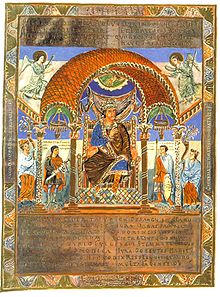
Back Залаты кодэкс Святога Эмера Byelorussian Codex aureus von St. Emmeram German Codex Aureus de San Emmeram Spanish Codex Aureus de Saint-Emmeran French Kodeks Aureus dari St. Emmeram ID Codex Aureus di Sant'Emmerano Italian Codex aureus van St. Emmeram Dutch Złoty Kodeks z St. Emmeram Polish Código Áureo de São Emeram Portuguese พระวรสารเซนต์เอมเมอแรม Thai




The Codex Aureus of St. Emmeram (Munich, Bayerische Staatsbibliothek, Clm 14000) is a 9th-century illuminated Gospel Book. It takes its name from Saint Emmeram's Abbey, where it was for most of its history (named after Emmeram of Regensburg) and is lavishly illuminated. The cover of the codex is decorated with gems and relief figures in gold, and can be precisely dated to 870, and is an important example of Carolingian art, as well as one of very few surviving treasure bindings of this date.[failed verification]
The upper cover of the Lindau Gospels is probably a product of the same workshop, though there are differences of style. This workshop is associated with the Holy Roman Emperor Charles II (the Bald), and often called his "Palace School". Its location (if it had a fixed one) remains uncertain and much discussed, but Saint-Denis Abbey outside Paris is one leading possibility.[1] The Arnulf Ciborium (a miniature architectural ciborium rather than the vessel for hosts), now in the Munich Residenz, is the third major work in the group, along with the frame of an antique serpentine dish in the Louvre.[2] Recent scholars tend to group the Lindau Gospels and the Arnulf Ciborium in closer relation to each other than the Codex Aureus to either.
- ^ Lasko, 60-68
- ^ Lasko, 64-65, 66-67; picture of the dish